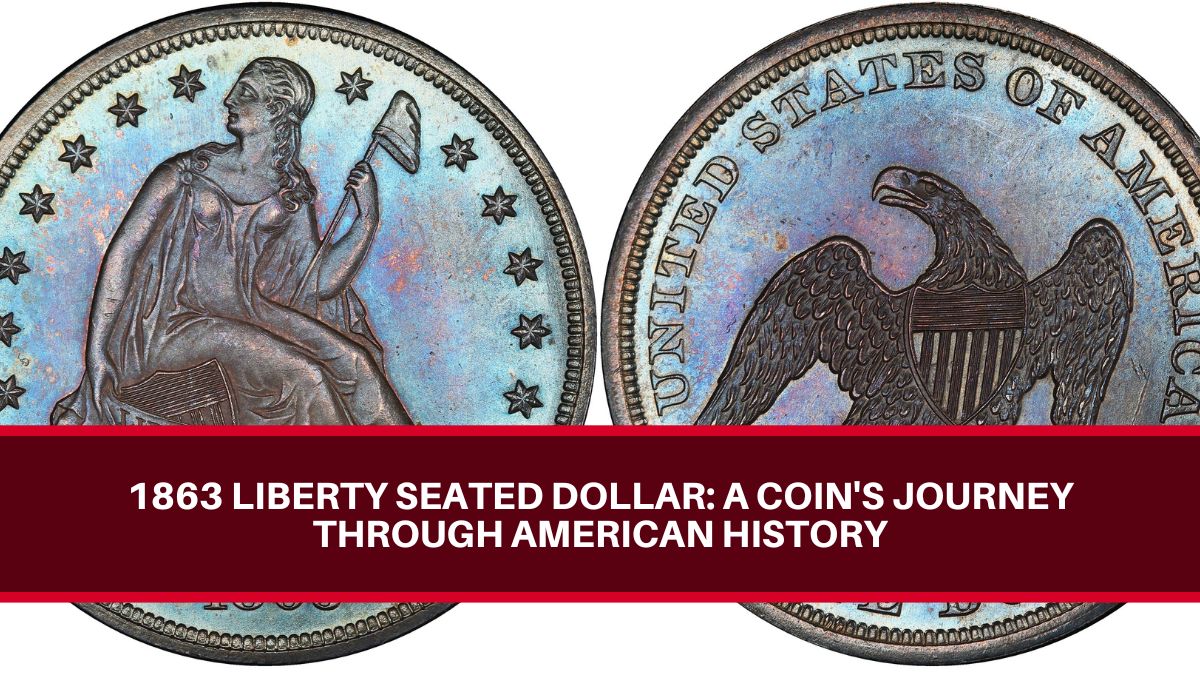Collecting coins can be a fascinating hobby, especially when it comes to historical pieces like the 1863 Liberty Seated Dollar. This coin not only holds significant value but also represents a unique moment in American history during the Civil War. In this guide, we will explore the background, production, and design of the 1863 Liberty Seated Dollar, making it easier for young collectors and history enthusiasts to understand its importance.
The Background of the 1863 Liberty Seated Dollar
When the Civil War broke out, the U.S. Mint faced many challenges in keeping coins circulating. Despite the efforts of the Mint, people began hoarding gold and silver coins. In 1861, the Treasury Department had five mint facilities, but three Southern mints stopped producing coins due to the war. Only the Philadelphia Mint and the California Mint continued operations, creating a scarcity of coins for regular use.
In early 1862, banks across the country began to stop using gold and silver coins altogether, leading to the introduction of paper money known as fractional currency and Greenbacks. However, the minting of silver and gold coins continued mainly for private collectors.
The Impact of the Civil War
The year 1863 was a turning point. On January 1, President Lincoln’s Emancipation Proclamation freed slaves in rebelling states and allowed black soldiers to join the Union Army. This change framed the war as a fight against slavery, which shifted European opinions in favor of the Union.
To support the war effort, the Enrollment Act of 1863 required all men aged 20 to 45 to register for the draft. This was crucial for the Union, which had a much larger population than the Confederacy. This act aimed to bolster troop numbers, especially after several Confederate raids into Northern states, culminating in the significant Battle of Gettysburg.
Production of the 1863 Liberty Seated Dollar
The 1863 Liberty Seated Dollar is known for its limited production. According to experts Dick Osburn and Brian Cushing, only one die marriage was used to create the coin, resulting in 27,200 business strikes and 460 Proofs. Most of these coins were made for private depositors and were often sent to South America and Asia, where they have largely remained.
Mintage Breakdown
Here’s how the mintage for the 1863 Liberty Seated Dollar was distributed:
| Date | Coins Struck |
|---|---|
| March 9, 1863 | 3,800 |
| March 26, 1863 | 1,400 |
| April 10, 1863 | 15,400 |
| November 22, 1863 | 6,600 |
| Total | 27,200 (+460 Proofs) |
As of August 2024, it is estimated that fewer than 500 of these coins are still in existence, making them quite rare.
Noteworthy Specimens
Certain specimens of the 1863 Liberty Seated Dollar have gained recognition in the coin market due to their exceptional quality and historical significance. For example:
- PCGS MS67: The highest graded coin, sold for up to $114,000.
- PCGS MS65: Coins in this category have been sold for significant amounts, often ranging between $31,200 and $57,500.
Collectors seek these high-graded coins due to their rarity and historical value.
Design Features of the 1863 Liberty Seated Dollar
The design of the 1863 Liberty Seated Dollar is both artistic and symbolic.
Obverse Design
The front of the coin shows Liberty seated on a rock, wearing flowing robes. She holds a Liberty pole in one hand and a shield with the word “LIBERTY” in the other. Surrounding her are thirteen stars, representing the original states, and the date “1863” is located at the bottom.
Reverse Design
The back features an eagle with outstretched wings. The eagle holds an olive branch and arrows, symbolizing peace and strength. The words “UNITED STATES OF AMERICA” are written around the eagle, with the denomination “ONE DOL.” at the bottom.
Specifications
| Feature | Details |
|---|---|
| Year of Issue | 1863 |
| Mintmark | None (Philadelphia) |
| Mintage | 27,200 coins |
| Weight | 26.73 g |
| Diameter | 38.10 mm |
| Alloy | 90% silver, 10% copper |
Conclusion
The 1863 Liberty Seated Dollar is not just a coin; it is a piece of history that reflects a significant time in America. Its production was limited during a time of great conflict, and it has become a sought-after item for collectors today. With only a few hundred remaining, owning one of these coins connects collectors to the past while also offering potential investment value. Whether you are a seasoned collector or just starting, understanding the history and significance of the 1863 Liberty Seated Dollar enhances the joy of coin collecting.
FAQ’s
What is the historical significance of the 1863 Liberty Seated Dollar?
he 1863 Liberty Seated Dollar was minted during the American Civil War, a time of great turmoil in the United States. It represents a unique blend of history and art, as the coin was produced amid significant social changes, including the Emancipation Proclamation, which framed the war as a fight against slavery.
How many 1863 Liberty Seated Dollars were produced?
A total of 27,200 business strikes of the 1863 Liberty Seated Dollar were minted, along with 460 Proofs. Due to their limited production, it is estimated that fewer than 500 examples of this coin still exist today, making them quite rare and valuable to collectors.
What are the key design features of the 1863 Liberty Seated Dollar?
The obverse features Liberty seated on a rock, holding a Liberty pole and a shield with the word “LIBERTY.” The reverse displays a majestic eagle with an olive branch and arrows, surrounded by the inscription “UNITED STATES OF AMERICA” and the denomination “ONE DOL.” The coin’s design reflects themes of freedom and strength.

